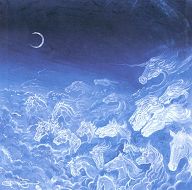
the archetypal mythology of horses
Copyright
2004-2022 Beverley Kane, MD
Page 3 of 20
of Revelations in the New Testament foretells the Four Horsemen of the Apocalypse
who will usher in the end of the world, the second coming of the Messiah, and God's
vanquishing of all evil. Muhammad, Vishnu, and Christ are all prophesied to return on a
white horse.
In many tales, Horse is an independent agent who corresponds to a singular
physical or psychological type. Pegasus alone stood among the Greek pantheon as a
god, sprung from the sea god Poseidon and the bleeding head of Medusa. Pegasus was
sacred to the Muses, and from his hoof sprang the Hippocrene fountain whose waters
conferred the gift for poetry in those who drank from it. No one was able to mount
Pegasus before Bellerophon sat astride him.
Bellerophon could not tame Pegasus until Athena
visited him in a dream. She handed him a golden
bridle and bade him ride Pegasus to defeat the
monstrous Chimaera. When Bellerophon awoke, he
held the golden bridle in his hands. Thus the bridling
of Pegasus symbolizes the rationality of Athena,
goddess of Wisdom, overcoming the instincts and
uncontrollable passions, represented by Pegasus in
his wild, unbridled state. The story also links the
dream world to the waking world. We are reminded
of our ability—the necessity—to use will and reason
to manifest in the physical the gifts from the seemingly chaotic, ephemeral, and
disconnected world of dreams, instincts, and imagination.
When we tell stories such as Good Luck Horse, Bad Luck Horse, recounted
below, we endow Horse with his own agency. When we examine horses in the dreams of
contemporary people, we will note whether they act as free agents or as physical
extensions of the dreamer.
ARCHETYPES AND PROJECTIONS OF MIND AND BODY
PSYCHOLOGICAL ARCHETYPES
Archetypes (Greek arche, original or beginning + type, form or pattern) is the Jungian
term for the blueprints for human personality and character essences that exist across all
cultures, throughout all time, in every individual. They are the straight-from-central-
casting roles that each society clothes in its own customs and prejudices—loving mother,
wise old man, beautiful princess, knight in shining armor, evil fiend, god and goddess,
beloved baby animal.
The entire cast of archetypes performs in every human psyche, usually in the
wings where we are unaware of them. Each of us is an omnipotential personality,
capable of expressing every archetype. Myths, folk legends, and fairy tales—remarkably
similar in all languages and cultures—are stories built around archetypal themes. Noting


